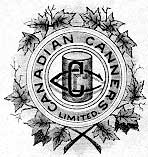INDUSTRIAL HAMILTON: A TRAIL TO THE
FUTURE
Canadian Canners Limited
Location: 44 Hughson Street South, Hamilton, Ontario
 Towards
the end of the 19th century there were several prosperous canning companies
in Canada. Ironically, their success also caused their downfall since after
a few years, output of canned goods exceeded consumption in Canada. Additionally,
exportation to the United States was not a possibility due to a prohibitive
duty on imported canned goods. By 1888 most of the canners had gone bankrupt
due to over-production, with only the most efficient companies having survived.
To help stabilize the canning industry, one can manufacturer and several wholesale
grocers formed the Dominion Syndicate in the 1890's. Its purpose was to take
over and finance the canning companies and then market them effectively. However,
the Dominion Syndicate had no control over the production and quality at the
individual factories and this caused its collapse.
Towards
the end of the 19th century there were several prosperous canning companies
in Canada. Ironically, their success also caused their downfall since after
a few years, output of canned goods exceeded consumption in Canada. Additionally,
exportation to the United States was not a possibility due to a prohibitive
duty on imported canned goods. By 1888 most of the canners had gone bankrupt
due to over-production, with only the most efficient companies having survived.
To help stabilize the canning industry, one can manufacturer and several wholesale
grocers formed the Dominion Syndicate in the 1890's. Its purpose was to take
over and finance the canning companies and then market them effectively. However,
the Dominion Syndicate had no control over the production and quality at the
individual factories and this caused its collapse.
In 1903 a group of independent packing and canning companies met at the Waldorf
Hotel in Hamilton. They decided to merge all their assets and form a company
to control production, financing, and distribution of canned food. The 16 companies
involved became Canadian Canners Consolidated Companies Limited. Subsequently,
head offices were established at 39 James Street South in Hamilton. In 1904,
the company's name was shortened to Canadian  Canners
Limited (C.C.) for the sake of convenience and the first of many additional
plants was purchased.
Canners
Limited (C.C.) for the sake of convenience and the first of many additional
plants was purchased.
Canadian Canners Limited realized that the quality of canned food depended
on the quality of the produce that went into the cans. With this in mind the
company started a subsidiary called Canners' Seeds Limited in 1905. This subsidiary
was devoted to developing and testing specialized seeds to produce superior
crops. By 1910 C.C. owned 30 canning factories, a lithography plant in London,
Ontario, a condensed milk plant in Aylmer, Ontario, and a warehouse in Hamilton.
It was at this time that consolidation took place and several independent canners
were merged with C.C. (whose name was changed to Dominion Canners Limited).
This merger helped reduce the cost of canning while adding 26 factories to Dominion
Canners' roster. By this time Dominion Canners' output constituted over 80%
of the output of canned fruits and vegetables in Canada.
 In
1912, Pembroke Shook Mills Limited was purchased to provide wooden shooks for
the cases that Dominion Canners made its shipments in. Also that year, Walmer
Transport Limited (based in Hamilton) was started by the company to ensure fast
delivery of customer orders and swift shipments of fresh produce to the canning
plants.
In
1912, Pembroke Shook Mills Limited was purchased to provide wooden shooks for
the cases that Dominion Canners made its shipments in. Also that year, Walmer
Transport Limited (based in Hamilton) was started by the company to ensure fast
delivery of customer orders and swift shipments of fresh produce to the canning
plants.
 In
1915, the canning industry faced huge carry-overs from 1914 due to declining
domestic consumption, high freight rates, and an abnormally large crop. In an
effort to save the industry, 50 Canadian independent canning plants associated
themselves with Dominion Canners for three years. Additionally, Dominion Canners
acquired all seven factories of the British Canadian Canners Limited. In 1917,
Dominion Canners expanded beyond Ontario purchasing three plants in British
Columbia and three plants in Québec. Two years later, the company purchased
the Bell Telephone building situated at 44 Hughson Street South, relocating
its head offices there. Also in 1919, Dominion Canners built a $1 million factory
in Hamilton which increased output greatly.
In
1915, the canning industry faced huge carry-overs from 1914 due to declining
domestic consumption, high freight rates, and an abnormally large crop. In an
effort to save the industry, 50 Canadian independent canning plants associated
themselves with Dominion Canners for three years. Additionally, Dominion Canners
acquired all seven factories of the British Canadian Canners Limited. In 1917,
Dominion Canners expanded beyond Ontario purchasing three plants in British
Columbia and three plants in Québec. Two years later, the company purchased
the Bell Telephone building situated at 44 Hughson Street South, relocating
its head offices there. Also in 1919, Dominion Canners built a $1 million factory
in Hamilton which increased output greatly.
 Eventually
the remaining Ontario independent canners decided, along with Dominion Canners,
that further amalgamation would be beneficial. Dominion Canners found it difficult
to reach financial security and experienced widely fluctuating earnings. So
in 1923, Dominion Canners Limited was renamed Canadian Canners Limited and 29
Canadian independent canners joined its ranks. This brought the total number
of plants owned or controlled by C.C. to 84. That number would not remain static
however. In 1925 Wagstaffe Limited (in Hamilton) was purchased by the company
and used as a facility for packing jams, jellies, and marmalades. C.C. continued
to expand during the 1930's, 40's, and 50's acquiring additional plants across
Canada. By 1956 C.C. (the largest food processing company in the British Empire)
had factories located in Nova Scotia, Québec, Ontario, Manitoba, and
British Columbia. It was at this time that the California Packing Corporation
(a.k.a. the Del Monte Corporation) obtained two thirds controlling interest
in the company. This marked the beginning of cutbacks for C.C. Within ten years
the number of canneries was reduced to 14. Furthermore, out of the more than
20 brands that C.C. once distributed, only two remained: Aylmer and Del Monte
(though each of these brands consisted of numerous products).
Eventually
the remaining Ontario independent canners decided, along with Dominion Canners,
that further amalgamation would be beneficial. Dominion Canners found it difficult
to reach financial security and experienced widely fluctuating earnings. So
in 1923, Dominion Canners Limited was renamed Canadian Canners Limited and 29
Canadian independent canners joined its ranks. This brought the total number
of plants owned or controlled by C.C. to 84. That number would not remain static
however. In 1925 Wagstaffe Limited (in Hamilton) was purchased by the company
and used as a facility for packing jams, jellies, and marmalades. C.C. continued
to expand during the 1930's, 40's, and 50's acquiring additional plants across
Canada. By 1956 C.C. (the largest food processing company in the British Empire)
had factories located in Nova Scotia, Québec, Ontario, Manitoba, and
British Columbia. It was at this time that the California Packing Corporation
(a.k.a. the Del Monte Corporation) obtained two thirds controlling interest
in the company. This marked the beginning of cutbacks for C.C. Within ten years
the number of canneries was reduced to 14. Furthermore, out of the more than
20 brands that C.C. once distributed, only two remained: Aylmer and Del Monte
(though each of these brands consisted of numerous products).
 In
1969 a $400,000 research centre was built in Burlington, replacing the previous
one located in Hamilton (which was used as office space from then on). In 1978
Wagstaffe Limited was consolidated with a plant in Leamington, Ontario (which
processed tomatoes) due to the loss of export markets for its products. With
the coming of the following year, several small canneries in and around the
Niagara peninsula closed due to pressure from large food retailers. C.C. was
able to survive owing to its well-known brand names as well as customer loyalty.
However, C.C. was not the giant it used to be. In 1982, two of its specialty
food plants were sold, along with the Walmer Transport Company Limited. Despite
these cutbacks, C.C. spent $15.2 million on an expansion, modernization, and
consolidation program (which was the largest capital expenditure in the company's
history). This program consisted of
In
1969 a $400,000 research centre was built in Burlington, replacing the previous
one located in Hamilton (which was used as office space from then on). In 1978
Wagstaffe Limited was consolidated with a plant in Leamington, Ontario (which
processed tomatoes) due to the loss of export markets for its products. With
the coming of the following year, several small canneries in and around the
Niagara peninsula closed due to pressure from large food retailers. C.C. was
able to survive owing to its well-known brand names as well as customer loyalty.
However, C.C. was not the giant it used to be. In 1982, two of its specialty
food plants were sold, along with the Walmer Transport Company Limited. Despite
these cutbacks, C.C. spent $15.2 million on an expansion, modernization, and
consolidation program (which was the largest capital expenditure in the company's
history). This program consisted of  closing
more plants (whose operations were consolidated at more efficient facilities),
expanding the tomato processing plant in Dresden, Ontario to allow for year-round
production, and upgrading the Simcoe and Leamington plants. By the end of 1983
C.C. had ten plants remaining in Canada.
closing
more plants (whose operations were consolidated at more efficient facilities),
expanding the tomato processing plant in Dresden, Ontario to allow for year-round
production, and upgrading the Simcoe and Leamington plants. By the end of 1983
C.C. had ten plants remaining in Canada.
In 1985, C.C.'s United States parent company R. J. Reynolds merged with the
American company Nabisco Brands Incorporated, causing C.C. itself to become part of
the Canadian company Nabisco Brands Limited in 1986. Since Nabisco Brands Limited
was located in Toronto the company moved there the following year, vacating
its head offices in Hamilton.
References:
- CF Hamilton - Industries - Canadian Canners Limited. Special Collections,
HPL.
- Herald, March 2, 1910. Special Collections, HPL.
- Herald, vol. I1, pt. 2, p. 8. Special Collections, HPL.
- Spectator, August 23, 1919. Special Collections, HPL.
Links:
 Towards
the end of the 19th century there were several prosperous canning companies
in Canada. Ironically, their success also caused their downfall since after
a few years, output of canned goods exceeded consumption in Canada. Additionally,
exportation to the United States was not a possibility due to a prohibitive
duty on imported canned goods. By 1888 most of the canners had gone bankrupt
due to over-production, with only the most efficient companies having survived.
To help stabilize the canning industry, one can manufacturer and several wholesale
grocers formed the Dominion Syndicate in the 1890's. Its purpose was to take
over and finance the canning companies and then market them effectively. However,
the Dominion Syndicate had no control over the production and quality at the
individual factories and this caused its collapse.
Towards
the end of the 19th century there were several prosperous canning companies
in Canada. Ironically, their success also caused their downfall since after
a few years, output of canned goods exceeded consumption in Canada. Additionally,
exportation to the United States was not a possibility due to a prohibitive
duty on imported canned goods. By 1888 most of the canners had gone bankrupt
due to over-production, with only the most efficient companies having survived.
To help stabilize the canning industry, one can manufacturer and several wholesale
grocers formed the Dominion Syndicate in the 1890's. Its purpose was to take
over and finance the canning companies and then market them effectively. However,
the Dominion Syndicate had no control over the production and quality at the
individual factories and this caused its collapse.
 Canners
Limited (C.C.) for the sake of convenience and the first of many additional
plants was purchased.
Canners
Limited (C.C.) for the sake of convenience and the first of many additional
plants was purchased. In
1912, Pembroke Shook Mills Limited was purchased to provide wooden shooks for
the cases that Dominion Canners made its shipments in. Also that year, Walmer
Transport Limited (based in Hamilton) was started by the company to ensure fast
delivery of customer orders and swift shipments of fresh produce to the canning
plants.
In
1912, Pembroke Shook Mills Limited was purchased to provide wooden shooks for
the cases that Dominion Canners made its shipments in. Also that year, Walmer
Transport Limited (based in Hamilton) was started by the company to ensure fast
delivery of customer orders and swift shipments of fresh produce to the canning
plants. In
1915, the canning industry faced huge carry-overs from 1914 due to declining
domestic consumption, high freight rates, and an abnormally large crop. In an
effort to save the industry, 50 Canadian independent canning plants associated
themselves with Dominion Canners for three years. Additionally, Dominion Canners
acquired all seven factories of the British Canadian Canners Limited. In 1917,
Dominion Canners expanded beyond Ontario purchasing three plants in British
Columbia and three plants in Québec. Two years later, the company purchased
the Bell Telephone building situated at 44 Hughson Street South, relocating
its head offices there. Also in 1919, Dominion Canners built a $1 million factory
in Hamilton which increased output greatly.
In
1915, the canning industry faced huge carry-overs from 1914 due to declining
domestic consumption, high freight rates, and an abnormally large crop. In an
effort to save the industry, 50 Canadian independent canning plants associated
themselves with Dominion Canners for three years. Additionally, Dominion Canners
acquired all seven factories of the British Canadian Canners Limited. In 1917,
Dominion Canners expanded beyond Ontario purchasing three plants in British
Columbia and three plants in Québec. Two years later, the company purchased
the Bell Telephone building situated at 44 Hughson Street South, relocating
its head offices there. Also in 1919, Dominion Canners built a $1 million factory
in Hamilton which increased output greatly.

 closing
more plants (whose operations were consolidated at more efficient facilities),
expanding the tomato processing plant in Dresden, Ontario to allow for year-round
production, and upgrading the Simcoe and Leamington plants. By the end of 1983
C.C. had ten plants remaining in Canada.
closing
more plants (whose operations were consolidated at more efficient facilities),
expanding the tomato processing plant in Dresden, Ontario to allow for year-round
production, and upgrading the Simcoe and Leamington plants. By the end of 1983
C.C. had ten plants remaining in Canada.